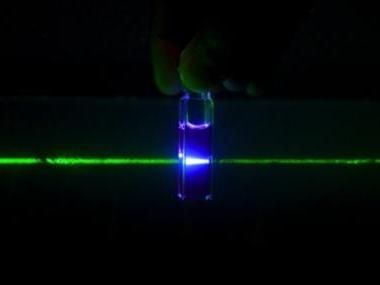Pushing the limits of solar cells
Florida State University researchers are striving to make solar cells more effective at trapping and using light.

Researchers used a self-assembly process where molecules work in concert to preform photon upconverion, combining two low energy, green photons to generate a higher energy, blue photon, which can then be used to generate electricity.
Courtesy of Ken Hanson
They're one step closer.
Assistant Professor of Chemistry and Biochemistry Kenneth Hanson and his team have introduced a new strategy for generating more efficient solar cells. The team is composed of post-doctoral researcher Tanmay Banerjee and graduate students Sean Hill and Tristan Dilbeck.
"We're looking not only for new materials but also new light harvesting processes to make solar cells better," Hanson said.
Though solar cells have grown in popularity, they are still not widely used by the general public as an energy source due to their high cost and low efficiency. A typical solar cell, at maximum, converts less than 33 percent of light into electricity, so researchers have been working to find ways to surpass this limit and make cells more efficient.
In the past, scientists have put an extra photon upconversion filter before or after the cell to catch the low energy, unused light and convert it into usable, high-energy light. But, Hanson wanted to integrate this process directly into the cell.
The researchers were able to do that by using self-assembly. Through a soaking procedure, they assembled two molecules, an acceptor and sensitizer, on a surface. Once assembled, these molecules work in concert to perform photon upconversion, combining two low energy, green photons to generate a higher energy, blue photon, which can then be used to generate electricity.
Using this process in an optimized solar cell can increase the maximum efficiency from 33 percent to more than 45 percent. The team is also confident they can generate even better numbers in the future.
"It's definitely a stepping stone toward making more efficient solar cells," Hanson said. "Our current work demonstrates a feasible method."
Scientists worldwide have been working on how to make more efficient solar cells through a variety of mechanisms and different materials. The solar market has grown considerably over the past few years, and as emphasis on clean energy grows, more resources will likely be devoted to creating better solar options.
Original publication
Other news from the department science

Get the chemical industry in your inbox
By submitting this form you agree that LUMITOS AG will send you the newsletter(s) selected above by email. Your data will not be passed on to third parties. Your data will be stored and processed in accordance with our data protection regulations. LUMITOS may contact you by email for the purpose of advertising or market and opinion surveys. You can revoke your consent at any time without giving reasons to LUMITOS AG, Ernst-Augustin-Str. 2, 12489 Berlin, Germany or by e-mail at revoke@lumitos.com with effect for the future. In addition, each email contains a link to unsubscribe from the corresponding newsletter.



























































